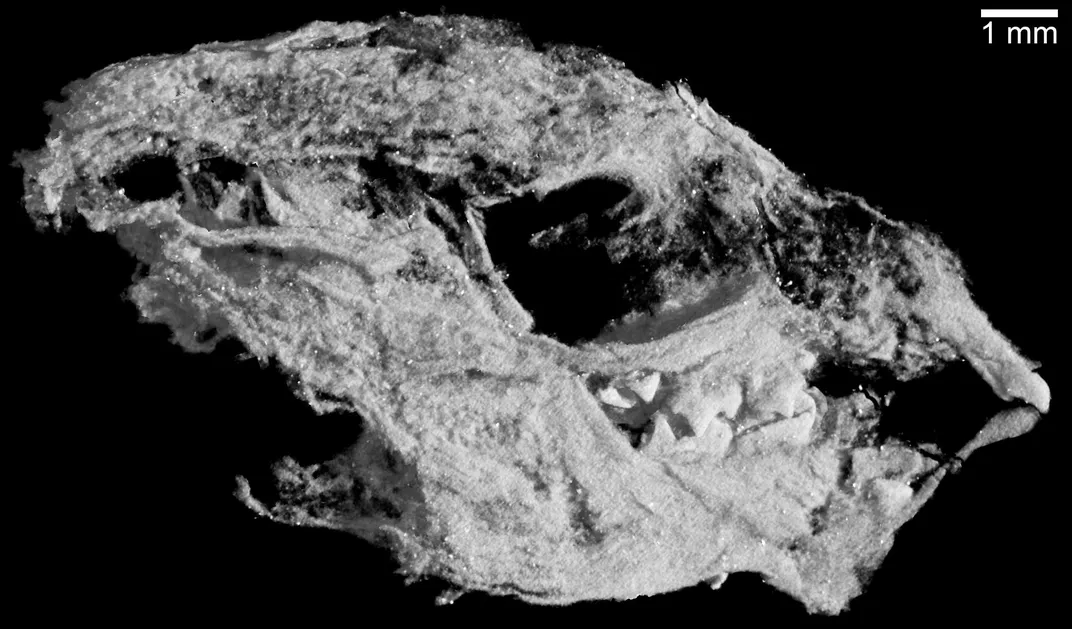Weasel-Like Fossils Reveal Evolutionary Clues of the First Mammals
A protomammal known as Kayentatherium was discovered with 38 babies in 185-million-year-old rock
:focal(384x493:385x494)/https://tf-cmsv2-smithsonianmag-media.s3.amazonaws.com/filer/7c/cd/7ccdc2e4-9652-4e9b-b6f8-9932ab841c2f/kayentatherium-38-babies-and-adult-768x994.jpg)
We tend to think of paleontology as an epic quest into the desert to recover pristine fossils, where groundbreaking discoveries are made by sun-singed explorers who stumble across the full skeletons of long-extinct behemoths. But this picture of fossil science isn’t how many important discoveries come to light. Sometimes stunning finds remain secret, even from scientists, until samples make it back to the lab. Such is the case with a distant protomammal relative of ours who was found with an entire litter of babies.
University of Texas at Austin graduate student Eva Hoffman detailed the discovery at the Society of Vertebrate Paleontology meeting in Albuquerque last month, and the findings have also been published in Nature.
The story of the special specimen goes back to 2000, Hoffman says. In that year, her advisor Timothy Rowe was searching the 185 million-year-old rock of Arizona for skeletons of a peculiar animal called Kayentatherium. This dog-sized animal was an ancient cousin of ours, belonging to a group called tritylodonts that has been associated with the evolution of the earliest mammals.
Among the finds during the 2000 field season was a Kayentatherium skeleton that time hadn’t treated very kindly. The bones of the skeleton had fallen out of articulation, Hoffman says, and the quality of the bone wasn’t ideal for analysis. Nevertheless, that year’s expedition collected the fossil and some of the surrounding stone for further study.

Nine years later, the secret of this skeleton finally became known. In 2009, preparator Sebastian Eggberts held up part of the stone surrounding the Kayentatherium skeleton and noticed a tiny jaw. The itty-bitty fossil looked just like the jaw of the adult, and researchers soon realized that there were dozens of baby Kayentatherium fossils contained within the rock samples.
“While we can never be 100 percent certain of the association between the adult and offspring, it seems like the most reasonable interpretation in this case,” says University of Washington paleontologist Christian Sidor. The fact that Kayentatherium and its kin are thought to have been digging animals, Sidor adds, could mean that the adult and babies were buried together in some kind of den.
Preparing the fossil by mechanical means was out of the question once the babies were discovered, lest any tiny bones be accidentally destroyed. Rowe’s lab started making digital scans of the fossil block to see what else might be inside, which became Hoffman’s project in 2016. When she was done, she counted the remains of 38 baby Kayentatherium alongside the adult.
This was quite a surprise. Previous research emphasized how Kayentatherium and its relatives had evolved to become rather mammal-like, Hoffman says, sharing traits with the first shrew-like mammals that appeared about 160 million years ago. But such a large clutch size fits a more reptilian way of reproducing than the typically mammalian method of having smaller litters which receive more parental care.
“What we see in the Kayentatherium babies is that their faces are very similar to the faces of the adults, so when they grow up they basically just scale up the same shape,” Hoffman says. This type of development is similar to the way baby reptiles grow after hatching, but distinct from mammalian growth in which babies often have short, big-eyed, cute faces that significantly change as they grow. Furthermore, the hands and wrists of the baby Kayentatherium were already structurally strong. When they hatched out of their eggs—just like the modern platypus or echidna—the Kayentatherium babies were ready to get moving.
/https://tf-cmsv2-smithsonianmag-media.s3.amazonaws.com/filer/81/30/8130e81f-5c7b-4ca0-9dba-67bb2a1e66ba/kayentatherium-tree.jpg)
The research provides clues to how our Jurassic ancestors went from a more reptile-like mode of reproduction to something resembling the propogation of modern mammals, but to find the transition point, additional analysis and discovery are needed. While some experts place animals like Kayentatherium close to the evolutionary lineage that spawned mammals, others see them as more distant protomammal cousins, Sidor says. Likewise, even closely-related reptiles can have different modes of reproduction, so what may have been true for Kayentatherium may not have been true for other species.
Still, Sidor says, “this is a really important and spectacular discovery,” particularly because the find fills in details of the life and behavior of Kayentatherium that experts never expected to find.
“This is a find that shows the importance of the fossil record,” Hoffman says. Without physical evidence of association between an adult and juveniles, the way animals like Kayentatherium reproduced would have remained obscured by a 185-million-year gap in time.
The most spectacular finds are not always as obvious as a giant dinosaur skeleton embedded in the bedrock, and this family of Kayentatherium serves as a reminder to “keep an eye out for stuff you’re not necessarily looking for,” Hoffman says, as there are surely more surprises waiting in the rock.
/https://tf-cmsv2-smithsonianmag-media.s3.amazonaws.com/accounts/headshot/RileyBlack.png)
/https://tf-cmsv2-smithsonianmag-media.s3.amazonaws.com/accounts/headshot/RileyBlack.png)